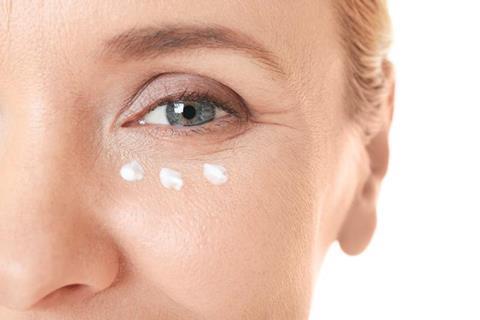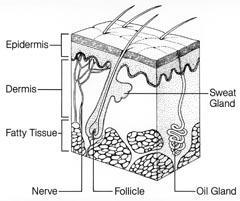The market for skin care products to help combat the signs of ageing is massive, with global sales projected to reach US $69.6 billion in 2010. But do anti-ageing creams work and what's the chemistry behind them?

As we get older our skin begins to show the outward signs of ageing with more wrinkles and sagging. There are numerous factors at work, including gravity, sun damage (photo-ageing) and even the way we use our facial muscles. What is it about the structure and chemical composition of the skin that is transformed with age and do skin care products such as anti-wrinkle creams really work?
Skin structure

The skin has two main layers - the outer epidermis which sits on top of the dermis. Under the dermis is a layer of subcutaneous ('under the skin') fat. The epidermis is made up of several layers, the deepest being the basal cell layer where cells continually divide to produce new skin cells. The number of cells in the epidermis decreases by around 10 per cent per decade and they divide more slowly. Consequently, the epidermal layer can't repair itself so quickly, and becomes thinner with age. By the time a person reaches 70 their skin can look thin and fragile.
The dermis contains collagen and elastin fibres, proteins that provide strength and flexibility. Collagen is made up of three protein strands wound together in a triple helix, giving it great tensile strength. Tough bundles of collagen - collagen fibres - support most tissues and give cells structure from the outside. Elastin is an elastic protein that allows the skin to go back to its original position after stretching or contracting. It is formed mostly of the amino acids alanine, glycine, valine and proline. The amino acid chains are cross-linked by another amino acid, lysine, to form large arrays. As we get older elastin fibres degrade and the skin loses its elasticity, and the dermis also produces less collagen. These changes, along with the loss of subcutaneous fat, result in wrinkles.
Anti-ageing creams
Cosmetic companies spend large amounts of time and money researching and developing new formulations, predominantly creams that slow down the signs of ageing. There is a wide range of ingredients used in such creams and all have different effects on the skin.
Alpha-hydroxy acids (AHAs), such as glycolic acid (1) and lactic acid (2), and beta-hydroxy acids (BHAs), such as salicylic acid (3), are commonly used in anti-ageing creams to remove dead cells from the surface layer of the skin. Dr Danka Tamburic, reader in cosmetic science at the London College of Fashion, told InfoChem: 'The acids degrade the structures (corneodesmosomes) in the epidermis, which hold cells together, with the result that the cells (corneocytes) shed easily. The skin responds by making new skin cells faster, which temporarily brings about a more youthful appearance'.
Other types of hydroxy acids used in anti-ageing creams are polyhydroxy acids (PHAs) - eg lactobionic acid (4). Scientists have found that these are less irritating to the skin than AHAs and the larger number of OH groups makes them better moisturisers. How well all these acids work, according to Tamburic, depends on their concentration. 'If you use five per cent lactic acid, it does help in increasing cell turnover. Anti-ageing creams normally contain an acid concentration of up to three per cent (because of the possible irritancy), so may be less effective at this concentration', she explains.
What about vitamins?
The effect of vitamin A (retinol (5)) on the skin was found by chance around 30 years ago. Scientists working on form-ulations containing vitamin A to treat acne noticed that patients' skin showed signs of fewer wrinkles, better colour and a youthful glow. Tamburic explains, 'Vitamin A promotes regeneration of the skin, similar to AHAs, but at a deeper level using different mechanisms, and normal cell turnover can be halved from around 28 to just 14 days'. Vitamin A also promotes the synthesis of the skin proteins collagen and elastin by inhibiting the production of collagenase and elastase - the enzymes that destroy such fibres.
There are many chemical forms of vitamin A. The most efficient in skin products is the acidic form - all-trans-retinoic acid (Tretinoin) - which is the only anti-ageing active ingredient approved by the US Food and Drug Administration, but specifically for use in prescription skin creams for acne. This is because Tretinoin has a strong effect on deep skin layers and could show a range of adverse effects, so it is classified as a drug, rather than cosmetic active.
Since all-trans-retinoic acid can't be used in commercial anti-ageing products, the second best thing, explains Tamburic, is the alcohol form of vitamin A - retinol. It is less efficacious, but visibly rejuvenates the skin. However, retinol is unstable, and would change its structure and efficacy in the product, so chemists had to come up with alternatives to produce similar effects. By chemically modifying retinol they produced the stable ester, retinyl palmitate. This ester penetrates the skin, where enzymes break it down into the active retinol.
Chemists have also used the technique of microencapsulation to stabilise and protect the vitamin. This involves packing the unstable active ingredients inside a small shell (between 1μm and 0.1 mm diameter), made up of various polymers. Tamburic points out, 'Vitamin A is the only active ingredient that has been proven to reverse the signs of ageing. However, if you stop using it everything goes back to the way it was before'.
Oxidative damage
The skin can also show signs of accelerated ageing as a result of external factors - uv radiation (too much sun), smoking cigarettes and air pollution. Ultraviolet radiation penetrates the skin, leading to the formation of very reactive free radicals. Some of these free radicals have a negative effect on the proteins in the skin, such as collagen and elastin, resulting in loss of strength and elasticity.
Vitamins E (α-tochopherols) and C (ascorbic acid (6)) are added to anti-ageing creams because they are antioxidants - they mop up the free radicals. Consequently cells suffer less damage, which means preventing more wrinkles.
Like vitamin A, however, vitamins E and C are unstable, so their ester forms are usually used in creams. Tamburic points out, 'if tochopheryl ethanoate, a stable ester of vitamin E, is used in combination with ascorbyl-2-phosphate (derived from vitamin C) it is even more effective. These compounds penetrate the skin, where the ester bonds are broken, giving the active antioxidants. More than one antioxidant is used because the free radical species have different reactivities'.
Peptide power
Peptides are now used in anti-ageing creams because they have similar beneficial effects to AHAs and retinol without the irritation that may occur with these other ingredients. Short chain peptides - three to six amino acids - are the most common and their size means they do not sit on the skin surface, but can penetrate into the epidermis. One example is palmitoyl pentapeptide-3 (Pal-KTTKS), the pentapeptide which has been proven to reduce wrinkles/fine lines . The molecule comprises five amino acids linked together attached to a fatty acid. The addition of a lipophilic (oil-loving) fatty acid to the hydrophilic (water-loving) pentapeptide helps the molecule penetrate the skin, which is essentially lipophilic, and stimulate the key constituents of the skin, including collagen and elastin. This is important because collagen production decreases with age and degraded elastin fibres start to accumulate, causing further skin damage.
Peptides are also now used to mimic the 'Botox effect'. Botox is botulinum toxin which when injected into the skin temporarily paralyses some facial muscles and reduces or eliminates wrinkles. Creams containing peptides can be used as an alternative to Botox. According to Tamburic, 'These peptides block neurotransmission - ie stop the nerve impulses that cause muscle contraction, so the muscles relax and you in fact reverse wrinkle formation. The effect, however, is less visible than the one achieved by botulinum injection'.
Research chemists will continue to play an integral part in developing the next generation of skin care products. With new sophisticated technologies coming on stream the door is open for more exciting developments to help combat the signs of ageing.
This article was originally published in The Mole









No comments yet